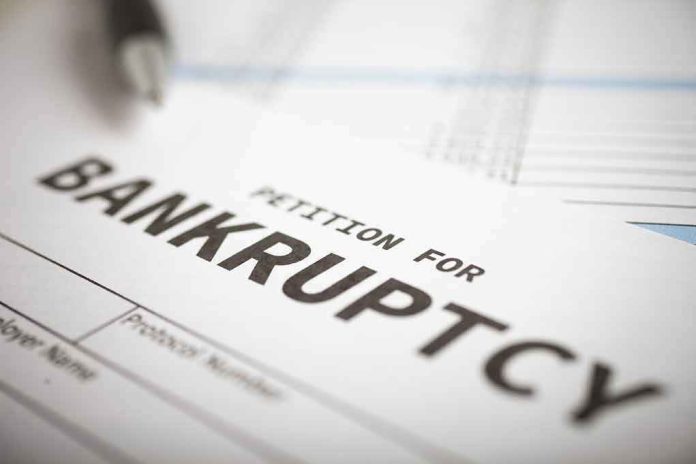
Americans are reeling as bankruptcy filings surge by 11.5% in just one year, exposing the devastating fallout of failed economic policies and years of reckless spending that left families and businesses gasping for air.
At a Glance
- Bankruptcy filings jumped 11.5% year-over-year—the sharpest rise since the aftermath of COVID-19.
- Persistent inflation, high interest rates, and record consumer debt drive the crisis, hitting households and businesses alike.
- Pandemic-era relief has vanished, leaving Americans exposed to soaring costs and renewed student loan burdens.
- Analysts warn the trend will worsen if economic conditions do not improve, with credit tightening and job losses looming.
Bankruptcy Wave Slams American Families and Small Businesses
The reality for countless Americans in 2025 is a bitter financial hangover. After years of government overspending, inflationary madness, and policies that rewarded everyone but working citizens, bankruptcy courts are now overflowing. In the first half of 2025 alone, filings shot up by 10% from the same period last year. That’s 276,126 Americans and businesses forced to wave the white flag—11.5% more than a year ago, and the largest increase since the initial COVID-19 fallout. Chapter 7 filings rose a staggering 15%, while Chapter 13 was up 3%—all pointing to a nation suffocating under the weight of debt and economic mismanagement. The so-called experts who promised “transitory inflation” have gone silent as ordinary people are left to pick up the pieces.
Personal bankruptcies are just the tip of the iceberg. Small businesses—the backbone of Main Street—are being crushed by surging interest rates and dwindling consumer spending. Commercial Chapter 11 filings spiked 62% in May before a brief dip in June, underscoring a volatile and hostile business environment. Pandemic-era relief programs are ancient history, and with student loan payments back in full swing, even those who once felt secure are now teetering on the edge. The collapse isn’t limited to a few unlucky sectors; it’s everywhere: retail, hospitality, local services—if you’re not a government-subsidized megacorporation or a well-connected political donor, you’re exposed.
Inflation, Debt, and the Disastrous Legacy of Government Overreach
What’s fueling this economic train wreck? It’s not a mystery—just ask any American who’s tried to buy groceries or fill up their gas tank. Persistent inflation has eroded real incomes, while the Federal Reserve’s interest rate hikes—meant to clean up the mess—have made it impossible for families and businesses to keep up with loan payments. Consumer and business debt have hit record highs, and delinquencies on credit cards and auto loans are now at multi-year peaks. The government’s one-size-fits-all approach—endless money printing, open checkbooks for special interests, and a total disregard for the consequences—has failed spectacularly. Now, with student loan repayments resumed and no relief in sight, millions are out of options. This is not just a “cycle” or a blip; it is the inevitable result of policies that prioritized political virtue-signaling, handouts to non-citizens, and the expansion of government power over the prosperity of everyday Americans.
Bankruptcy courts and legal aid offices are stretched to their limits, forced to triage the fallout. Creditors are tightening their standards, making it even harder for struggling families to get a break. Small businesses are closing their doors, taking jobs and community stability with them. The ripple effects will be felt for years, as credit dries up, borrowing costs climb, and the American Dream slips further out of reach for the middle class. Meanwhile, the so-called “solutions” offered by the last administration did nothing but kick the can down the road, leaving a mountain of debt and a legacy of broken promises. Every day, more Americans are learning firsthand what happens when government puts ideology over common sense and fiscal responsibility.
Analysts Warn: Economic Pain Will Persist Without Real Change
Industry experts and legal professionals are sounding the alarm: this surge in bankruptcy filings is just the beginning unless the fundamentals change. Data from Epiq AACER and the American Bankruptcy Institute—two of the most respected authorities in the field—paint a grim picture. “Elevated interest rates, record-high credit card and household debt, and the resumption of student loan repayments and collections are all contributing factors driving more individuals to seek bankruptcy protection,” says Michael Hunter of Epiq AACER. Legal analysts add that as long as inflation stays high and wage growth lags behind, bankruptcy rates are set to climb even higher. The only certainty is more pain, more closures, and more families forced to make impossible choices, unless policymakers finally put American citizens and fiscal sanity first.
For those on Main Street, this isn’t just a statistic—it’s a daily battle for survival. The experts may argue over the details, but everyone agrees on one thing: the economic storm unleashed by years of reckless government policy is far from over, and its casualties are piling up from coast to coast.
Sources:
Epiq Global: Total Bankruptcy Filings Increased 10 Percent in the First Half of 2025
Epiq Global: May Commercial Chapter 11 Filings Increase 62 Percent Over Last Month





